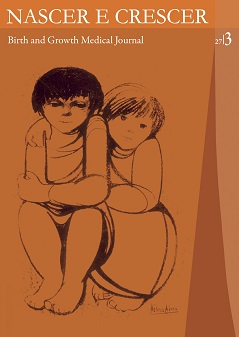Acromicric dysplasia and hearing loss: A case report
DOI:
https://doi.org/10.25753/BirthGrowthMJ.v27.i3.13190Keywords:
Bone dysplasias, hearing loss, hearing impairment rehabilitationAbstract
Introduction: Acromicric dysplasia is an extremely rare autosomal dominant bone dysplasia characterized by progressive growth retardation, short hands and feet, mild facial dysmorphism and generalized joint limitation. Association with ear, nose and pharyngolaryngeal alterations has been previously reported. However, little is known about the otolaryngologic aspects that may accompany this disease. We pretend to raise awareness to the otolaryngologic aspects that may accompany acromicric dysplasia and to the possible interventions that improve these patients quality of life.
Clinical Case: We present the case of a ten-year-old girl referred to the otorhinolaryngology consultation with complaints of progressive hearing loss. Hearing evaluation confirmed bilateral severe mixed hearing loss and the patient was successfully rehabilitated with bone-anchored hearing aids.
Discussion/Conclusions: Evaluation by an otolaryngologist should be part of the management of children with bone dysplasias, especially if they present with associated symptoms, to allow an early diagnosis and proper intervention.
Downloads
References
Maroteaux P, Stanescu R, Stanescu V, Rappaport R. Acromicric dysplasia. Am J Med Genet 1986;24:447-9
Le Goff C, Mahaut C, Wang LW, Allali S, Abhyankar A, et al. Mutations in the TGFbeta binding-protein-like domain 5 of FBN1 are responsible for acromicric and geleophysic dysplasias. Am J Hum Genet 2011;89:7–14.
Klein C, Le Goff C, Topouchian V, Odent S, Violas P, Glorion C, Cormier-Daire V. 2014. Orthopedics management of acromicric dysplasia: follow up of nine patients. Am J Med Genet Part A 164A:331–337.
Faivre L, Merrer M, Baumann C, Polak M, Chatelain P, Sulmont V, Cousin J, Bost M, Cordier MP, Zackai E, Russell K, Finidori G, Pouliquen JC, Munnich A, Maroteaux P, Cormier-Daire V. Acromicric dysplasia: long term outcome and evidence of autosomal dominant inheritance. J Med Genet 2001;38:745–749
Hasegawa K, Numakura C, Tanaka H, Furujo M, Kubo T, Higuchi Y, Yamashita M, Tsukahara H. Three cases of Japanese acromicric/geleophysic dysplasia with FBN1 mutations: a comparison of clinical and radiological features. J Pediatr Endocrinol Metab. 2017 Jan 1;30(1):117-121. doi: 10.1515/jpem-2016-0258
Teunissen EB, Cremers WR. (1993). Classification of congenital middle ear anomalies. Report on 144 ears. Ann Oto Rhinol Laryngol. 1002(8Pt1)606-12.
Downloads
Published
How to Cite
Issue
Section
License
Copyright and Authors' Rights
All articles published in Nascer e Crescer - Birth and Growth Medical Journal are Open Access and comply with the requirements of funding agencies or academic institutions. For use by third parties, Nascer e Crescer - Birth and Growth Medical Journal adheres to the terms of the Creative Commons License "Attribution - Non-Commercial Use (CC-BY-NC)".
It is the author's responsibility to obtain permission to reproduce figures, tables, etc. from other publications.
Authors must submit a Conflict of Interest statement and an Authorship Form with the submission of the article. An e-mail will be sent to the corresponding author confirming receipt of the manuscript.
Authors are permitted to make their articles available in repositories at their home institutions, provided that they always indicate where the articles were published and adhere to the terms of the Creative Commons license.


